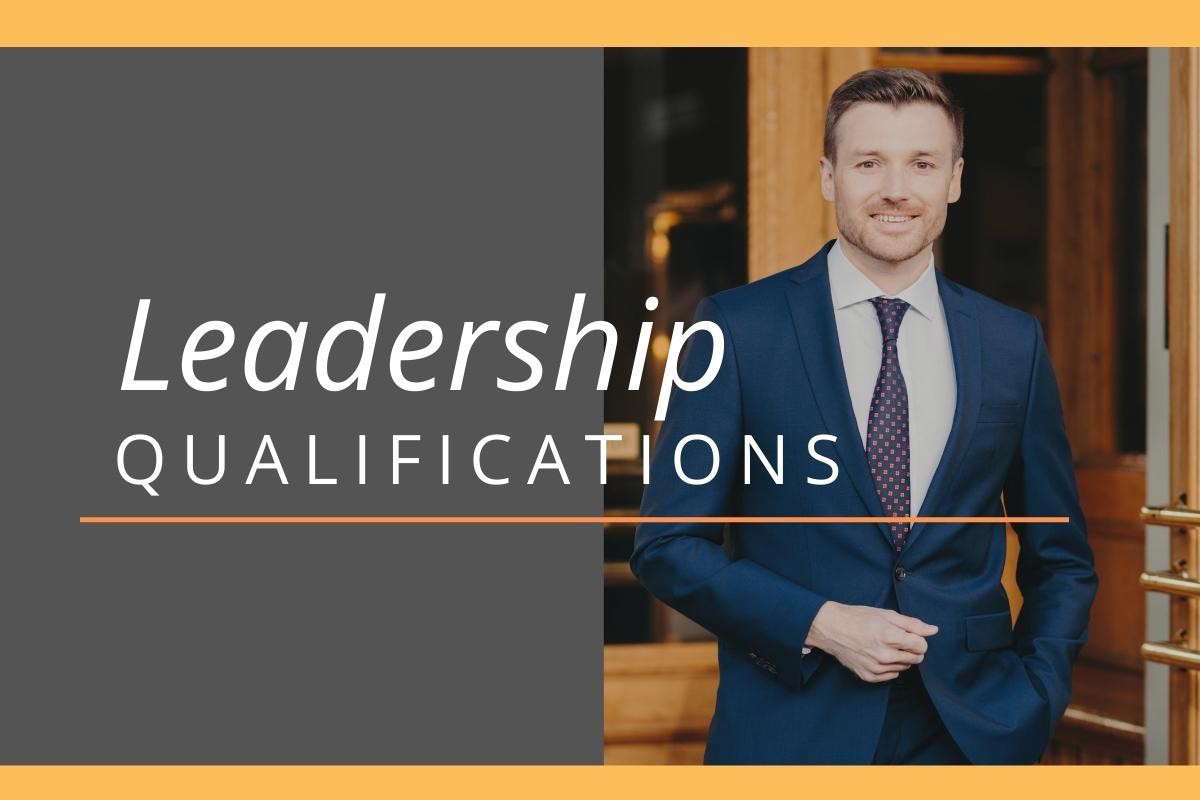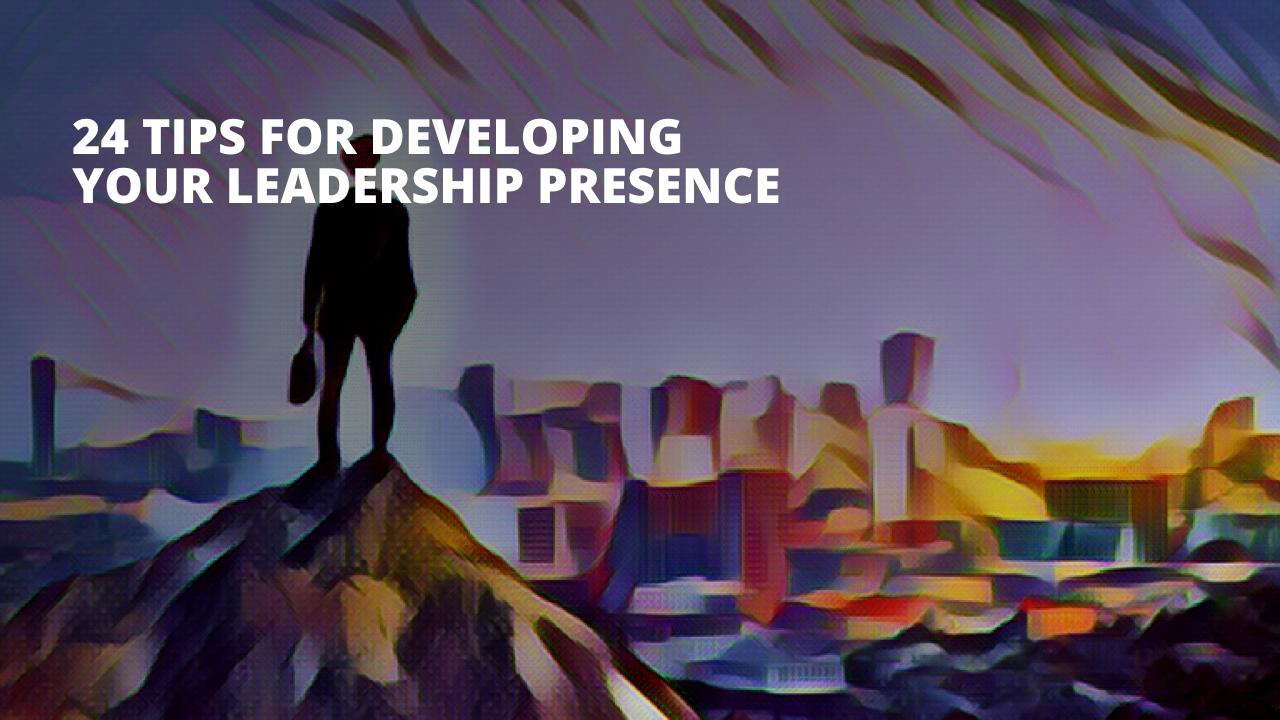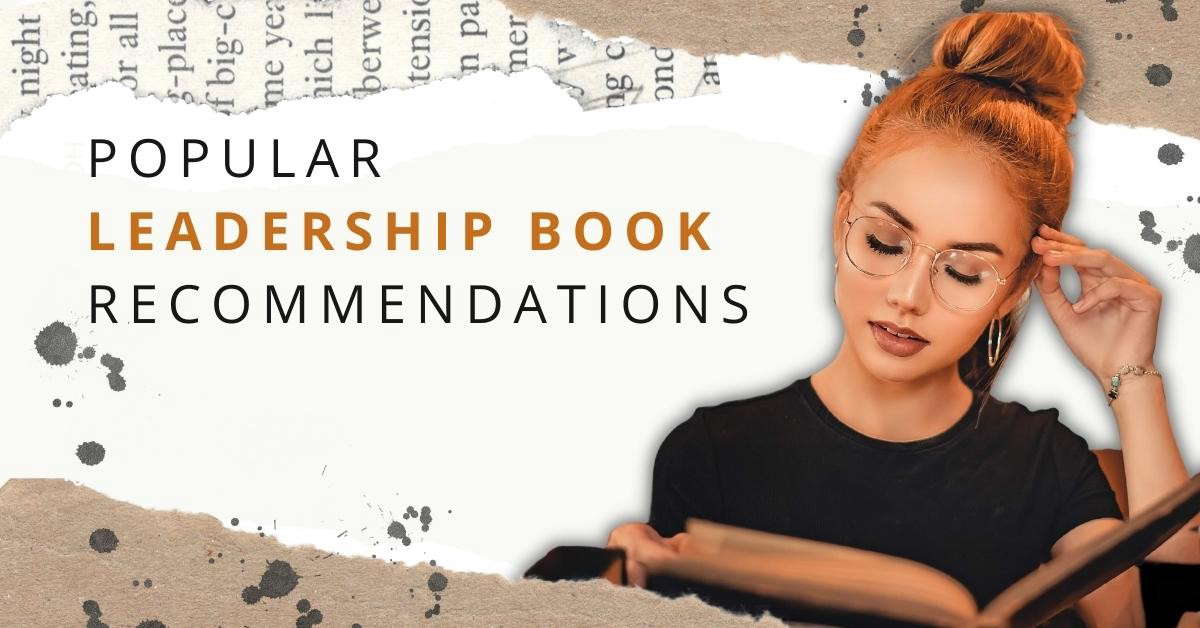
The guild model is an alternative organizational structure designed to address some of the weaknesses of the traditional matrix model. It involves organizing teams around products or product lines and forming communities of practice or "guilds" that provide members with standards and practices for their particular function.
This gives product leaders greater authority and autonomy in directing their squads while reducing the burden of stakeholder management. Product leaders can use the TIPS framework to determine where guild leaders fit in the stakeholder priority list, and examples of guilds include UX guilds and front-end developers guilds.
Introduction
What This Means for Product Leaders
TIPS Framework
Examples of Guilds
Conclusion
Introduction: The guild model is a unique organizational structure popularized by Spotify in 2012. It is an alternative to the traditional matrix model and is designed to address some of the weaknesses of the matrix model.
It involves organizing teams around products or product lines and forming communities of practice or "guilds" that provide members with standards and practices for their particular function. This has several implications for product leaders, giving them greater authority and autonomy in directing their squads while reducing the burden of stakeholder management.
What This Means for Product Leaders
The guild model gives product leaders greater authority and autonomy in directing their squads. This is because the team members are aligned primarily to products or product lines rather than formal reporting lines. This means that product teams are freer to take or ignore their colleagues' advice, which may result in more efficient decision-making and increased productivity.
At the same time, the guild model also reduces the burden of stakeholder management. This is because the guilds are not formal authority structures and therefore do not require the same kind of oversight and management as traditional matrix models. This allows product leaders to focus on their core product responsibilities rather than managing and coordinating with stakeholders constantly to manage and coordinate with stakeholders constantly.
TIPS Framework
Building Strategic Relationships Making a Smooth Executive Transition
Unlocking Niches: Divisional Structure for Successful Corporations
For product leaders to effectively utilize the guild model, they must first determine where guild leaders fit in the stakeholder priority list. This can be done by using the TIPS framework, which stands for:
T - Trust: Guild leaders should be trusted to make decisions that are in the product's best interest.
I - Influence: Guild leaders should have a degree of influence over the product.
P - Power: Guild leaders should have the power to make decisions and execute them.
S - Support: Guild leaders should have the support of the product team and other stakeholders.
Examples of Guilds
One example of a guild is the UX guild, which defines best practices for user research. Another example is the front-end developers guild, which advices choosing a javascript framework and organizing contributions to a widget library. These guilds are usually led by a senior practitioner who hires and fires, assigns members to teams, and leads efforts to define best practices or develop reusable templates, libraries, etc.
Conclusion: The guild model is a unique organizational structure popularized by Spotify in 2012. It is designed to address some of the weaknesses of the matrix model and involves organizing teams around products or product lines and then forming communities of practice or "guilds" which provide members with standards and practices for their particular function.
This has some implications for product leaders, as it gives them greater authority and autonomy in directing their squads while reducing stakeholder management's burden. Product leaders should use the TIPS framework to determine where guild leaders fit in the stakeholder priority list. They should look to examples such as the UX guild and the front-end developers guild for guidance on how to structure their guilds.
Leadership in the Guild Model is not a solo journey; it requires collaboration and collective effort to achieve success.
Related Course: Leadership Training Course

Frequently Asked Questions
What is the guild model?
The guild model is an organizational structure popularized by Spotify in 2012 to address some of the weaknesses of the matrix model. It involves organizing teams around products or product lines and forming communities of practice or "guilds" that provide members with standards and practices for their particular function.
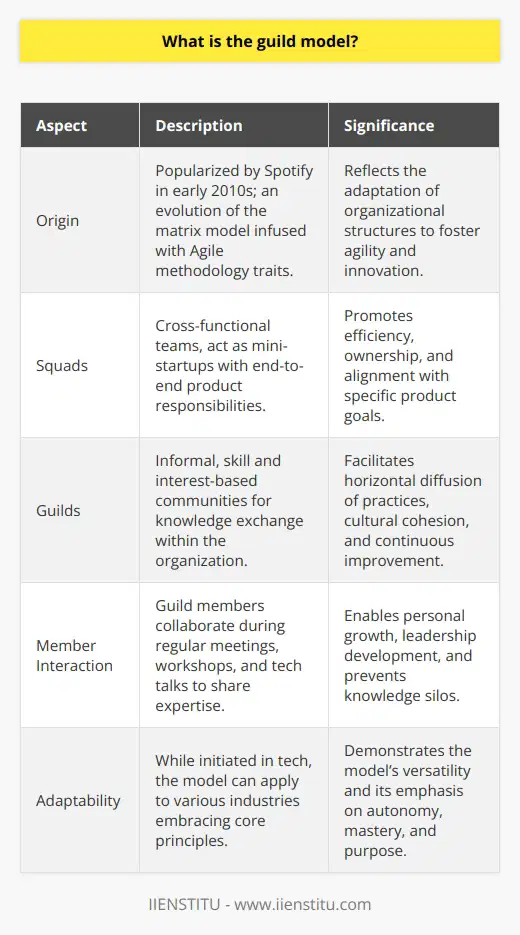
How does this give product leaders more authority?
The guild model gives product leaders greater authority and autonomy in directing their squads because team members are aligned primarily to products or product lines rather than formal reporting lines.
This means that product teams are freer to take or ignore their colleagues' advice, which may result in more efficient decision-making and increased productivity.
What is the TIPS framework?
The TIPS framework stands for Trust, Influence, Power, and Support - four core elements to consider when determining where a guild leader should fit into a stakeholder priority list.
Trust indicates whether they should be trusted to make decisions that align with what’s best for the product.
Influence provides insight into how much power they should have over decisions.
Power alludes to how much power they should have over decision-making and execution.
Support measures the support that guild leaders should receive from product teams and other stakeholders.

How do you achieve product leadership in a competitive market?
Product Leadership Strategies
Achieving product leadership in a competitive market requires implementing strategies that set a company's product offerings apart from the competition. This goal can be accomplished through relentless innovation, exceptional customer value, and continuous improvement.
Innovation Focus
Leading firms must establish an organizational culture that fosters creativity and encourages employees to think outside the box. By investing in research and development, organizations can create products with unique features and benefits that competitors cannot match. Continuous product innovation is essential to staying ahead of competitors and capturing market share.
Customer Value Offerings
A crucial aspect of product leadership is creating exceptional customer value. This can be achieved by offering products that address unmet customer needs, providing high-quality products at competitive prices, and adding unique value through superior customer service or additional offerings. Focusing on customer experience and promoting loyalty can also strengthen a company's reputation and ensure long-term success in the market.
Continuous Improvement
Finally, an organization must embrace a continuous improvement mindset to maintain product leadership. This involves regularly reevaluating its products and processes to identify areas for improvement and incorporating customer feedback to drive enhancement. Additionally, staying up-to-date on industry trends and emerging technologies can help identify new opportunities for product innovation.
In conclusion, achieving product leadership in a competitive market necessitates a multifaceted approach, focusing on innovation, customer value, and continuous improvement. By fostering a culture of innovation, offering exceptional value to customers, and constantly evolving, companies can stay ahead of competitors and maintain their position as industry leaders.
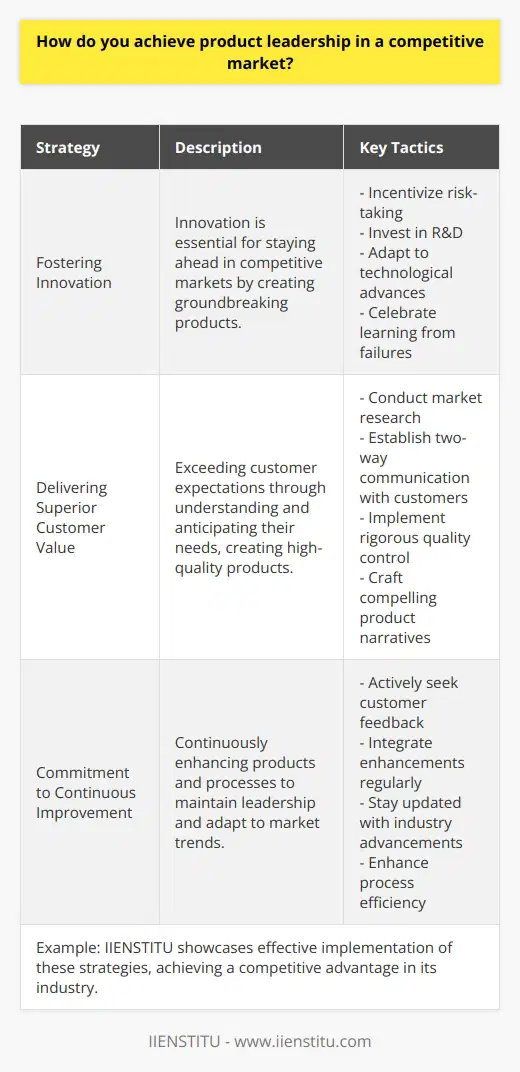
What are the key leadership actions that a product manager must undertake to ensure their team's effectiveness and success?
**Product Vision and Strategy**
A critical leadership action for a product manager is to develop a clear product vision and strategy. This involves defining the product's goals, target audience, and unique value proposition. By providing a solid strategic direction, the product manager enables their team to make informed decisions and prioritize tasks, leading to improved effectiveness and success in meeting business objectives.
**Stakeholder Management and Communication**
Product managers must also excel at managing relationships with various stakeholders, such as customers, executives, and cross-functional teams. This requires effective communication skills, including the ability to present complex information concisely and persuasively. Establishing trust and rapport with stakeholders ensures that the product manager can efficiently gather input, manage expectations, and garner support for critical initiatives.
**Resource Allocation and Prioritization**
A crucial responsibility in leading an effective team is appropriately allocating resources and prioritizing tasks. Product managers must make data-informed decisions to determine which projects and features deserve attention and investment. This entails assessing their potential impact and return on investment, as well as considering the team's capacity and capabilities. By making strategic choices, product managers reduce waste and maximize their team’s potential for success.
**Talent Development and Empowerment**
Successful product managers recognize the importance of nurturing and supporting their team members. Through regular feedback and coaching, product managers can identify areas for growth while helping their team develop the skills required for their roles. Additionally, by fostering a culture of trust and empowerment, they can encourage team members to take calculated risks and make data-driven decisions independently, promoting efficiency and innovation.
**Agile and Adaptive Leadership**
Lastly, product managers need to demonstrate agile and adaptive leadership in response to changing market conditions or feedback from stakeholders. This entails staying up to date with industry trends, customer preferences, and technological advancements, and adjusting the product strategy when needed. By fostering a flexible and continuous improvement mindset within their team, product managers can better navigate uncertainty and ensure sustained success.
In conclusion, effective product management requires a combination of strategic thinking, strong communication, resource prioritization, talent development, and adaptive leadership. By mastering these key leadership actions, product managers ensure that their teams are well-equipped to meet their goals and drive product success in a competitive and ever-changing marketplace.

How can a product leader continually adapt and evolve their guiding principles to drive innovation and growth within their organization?
**Understanding the Market**
A product leader can continually adapt and evolve their guiding principles by staying updated on the ever-changing market trends and consumer preferences. This can be achieved through constant research, attending industry events, and actively engaging with customers to gain insights into their needs and expectations. By understanding the market dynamics, a product leader can make informed decisions and develop innovative strategies that cater to the unique requirements of their target audience and ultimately drive growth within their organization.
**Embracing Experimentation**
Experimentation is key for any product leader looking to foster a culture of innovation within their organization. By nurturing an environment where team members feel encouraged to take risks and explore new ideas, a product leader can unlock new avenues of growth and address emerging challenges. Adopting an iterative approach and embracing the concept of 'fail-fast' allows product leaders to continually refine their guiding principles and improve the effectiveness of their strategies.
**Leveraging Data and Analytics**
In today's data-driven world, utilizing analytics to inform decision-making is essential for the success of any product leader. By tracking key performance indicators (KPIs) and analyzing customer data, leaders can gain valuable insights that enable them to make better-informed decisions and optimize product performance. By harnessing the power of data and analytics, product leaders can constantly update their guiding principles in response to new findings, ensuring that their strategies remain aligned with shifting market demands.
**Cross-functional Collaboration**
In order to drive innovation and growth within an organization, product leaders should encourage cross-functional collaboration among various teams. This integrated approach to problem-solving ensures a more comprehensive understanding of the challenges faced by the organization and promotes the development of more innovative solutions. By fostering a culture of open communication and collaboration, product leaders can not only refine their guiding principles but also ensure effective implementation.
**Continuous Learning and Up-skilling**
Lastly, product leaders must embrace continuous learning and up-skilling to stay relevant in their respective fields. By actively participating in workshops, industry webinars, and pursuing professional certifications, product leaders can equip themselves with the latest knowledge and skills necessary to drive innovation and growth within their organization. This commitment to lifelong learning enables product leaders to remain adaptable and evolve their guiding principles as they navigate the ever-changing landscape of product management.
In conclusion, a product leader can continually adapt and evolve their guiding principles by understanding the market, embracing experimentation, leveraging data and analytics, encouraging cross-functional collaboration, and committing to continuous learning and up-skilling. This dynamic approach to product leadership ensures that organizations remain at the forefront of innovation and are well-positioned for sustained growth.
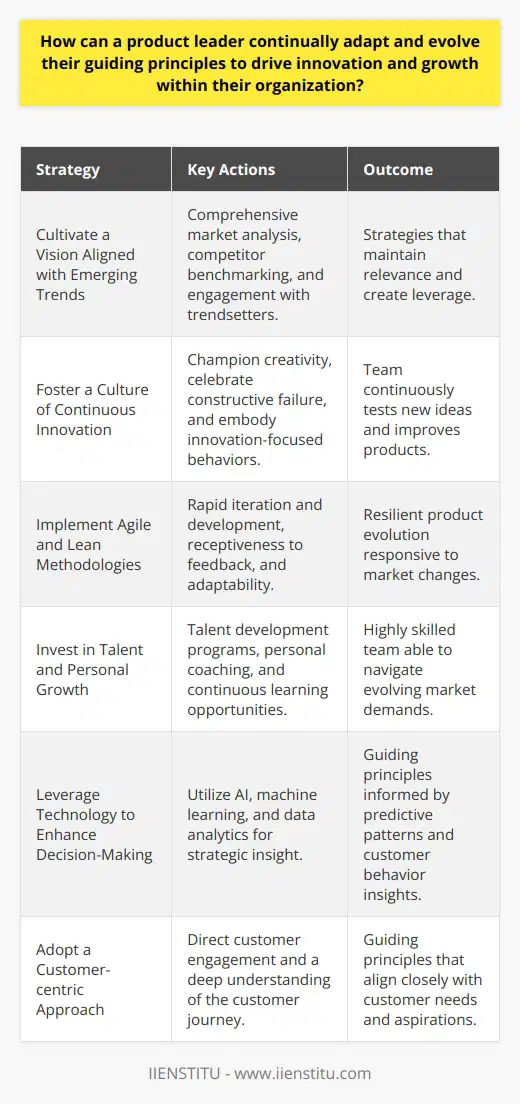
How do you achieve product leadership in a rapidly changing industry?
Achieving Product Leadership
**Understanding the Market**
To achieve product leadership in a rapidly changing industry, it is crucial to have a comprehensive understanding of the market. This includes identifying the target audience, analyzing the competition, and remaining up-to-date with technological advancements and global trends. By closely monitoring the market, an organization can adapt its product offerings to cater to consumer needs and preferences effectively.
**Innovation and Continuous Improvement**
Another fundamental element of achieving product leadership is fostering a culture of innovation and continuous improvement within the organization. Encouraging employees to explore new ideas and take calculated risks, as well as investing in research and development, ensures that the company remains at the forefront of technological advancements in the industry. Continuous improvement also involves refining existing products and services to deliver enhanced value, taking into account customer feedback to make informed improvements.
**Differentiation and Value Proposition**
Product leaders distinguish themselves from competitors by emphasizing differentiation and offering unique value propositions. This can be accomplished by developing high-quality products with advanced features, exceptional performance, or a distinctive design that sets the product apart from the competition. By delivering unparalleled value, product leaders can command premium pricing and build customer loyalty.
**Agile Practices and Adaptability**
Implementing agile practices and maintaining adaptability is essential in a rapidly changing industry. Agile methodologies, such as Scrum or Lean processes, emphasize adaptability, collaboration, and continuous learning. These practices allow organizations to be responsive to changing market conditions and customer expectations, enabling them to deliver superior products quickly and efficiently. Embracing adaptability also involves being open to change and embracing novel ideas, such as strategic collaborations, acquisitions, or partnerships that can strengthen the organization's product leadership position.
**Customer-centric Approach**
Lastly, product leaders adopt a customer-centric approach to ensure that their offerings resonate with customer needs and demands. This involves engaging with customers to gather insights, feedback, and suggestions on various aspects of the product, such as features, design, and pricing. By placing the customer at the center of decision-making, organizations can optimize their products to appeal to their target audience and deliver an exceptional customer experience.
In conclusion, achieving product leadership in a rapidly changing industry requires a combination of understanding the market, promoting innovation and continuous improvement, differentiating products, embracing agile practices, and adopting a customer-centric approach. By mastering these aspects, organizations can stay ahead of the competition and ensure sustained growth and success in an ever-evolving market landscape.
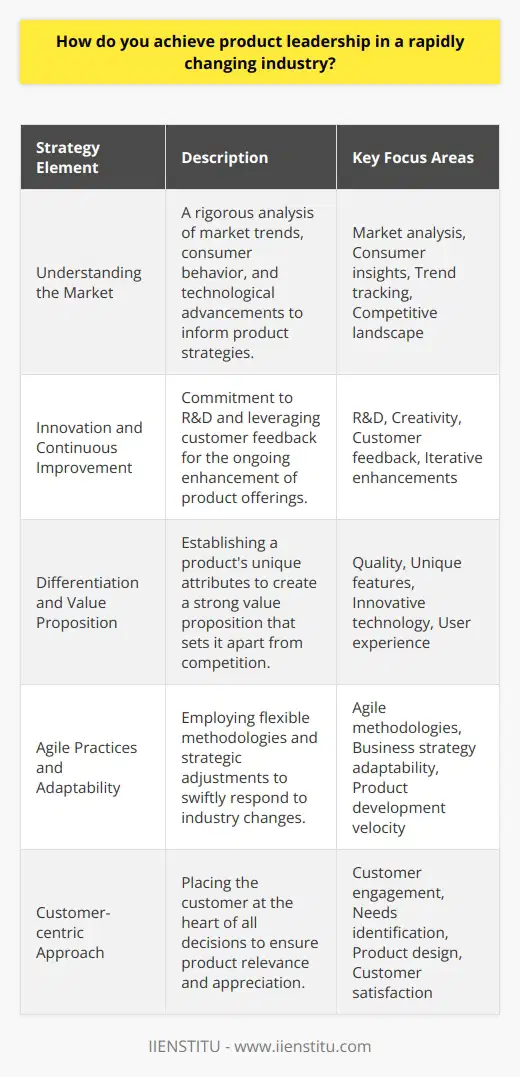
What are the critical leadership actions that a product manager must take to ensure successful collaboration within a multidisciplinary team?
Effective Communication
A critical leadership action that a product manager must take to ensure successful collaboration within a multidisciplinary team is effective communication. Clear, concise, and transparent dialogue is essential for fostering teamwork, aligning objectives, and resolving conflicts. This includes establishing a consistent method for sharing updates and soliciting feedback to maintain open channels of communication among team members.
Empathy and Cultural Sensitivity
Additionally, a product manager should demonstrate empathy and cultural sensitivity, recognizing the diverse backgrounds and perspectives of team members. This entails listening actively and respectfully, being aware of implicit biases, and fostering an inclusive environment that values contributions from all individuals, regardless of their background or expertise.
Delegation and Empowerment
Moreover, successful collaboration hinges on the product manager's ability to delegate tasks equitably and empower team members to take ownership of their responsibilities. This requires recognizing the unique strengths and capabilities of each individual, ensuring the assignment of tasks aligns with their expertise and fosters both personal and collective growth.
Conflict Resolution
The product manager must also be adept at conflict resolution, addressing issues that may arise within the multidisciplinary team promptly and constructively. This involves mediating disputes, soliciting input from all parties, and seeking solutions that promote collaboration and harmony. By maintaining open lines of communication, fostering a culture of respect, and cultivating a solution-oriented mindset, the product manager can effectively quell tensions and preserve team cohesion.
Vision and Focus
Lastly, a product manager should maintain a clear vision for the project's goals, ensuring that all team members understand the overarching objectives and remain focused on achieving them. This involves consistently reinforcing the project's purpose, monitoring progress, and adjusting strategies as needed to ensure the team remains on track.
In summation, for a product manager to ensure successful collaboration within a multidisciplinary team, they must prioritize effective communication, empathy and cultural sensitivity, delegation and empowerment, conflict resolution, and maintaining vision and focus. By adopting these critical leadership actions, the product manager can foster a cohesive and productive team environment that delivers exceptional results.
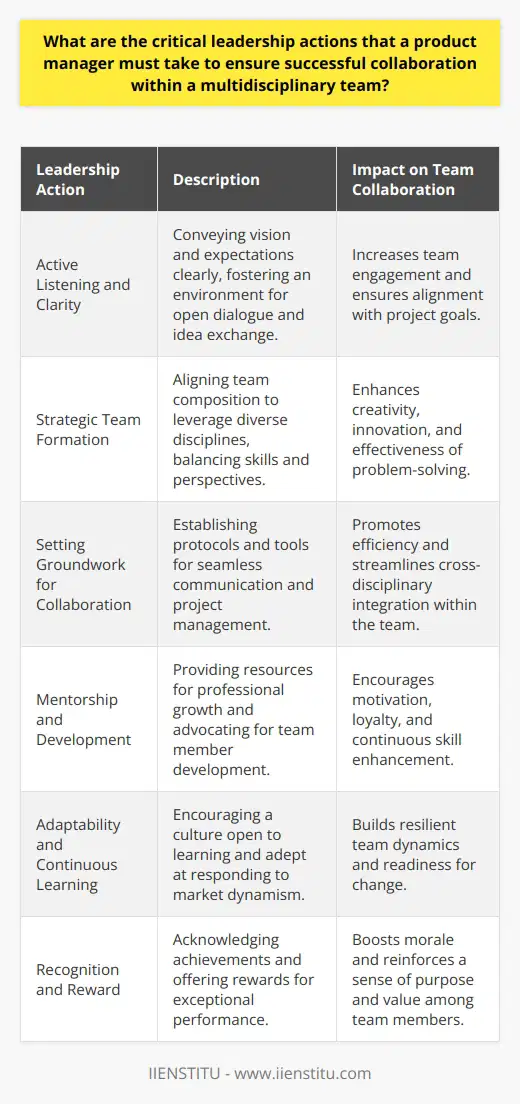
How can a product leader effectively navigate and balance competing priorities and stakeholder expectations?
**Understanding Stakeholder Expectations**
To effectively navigate and balance competing priorities and stakeholder expectations, a product leader must collect, analyze, and understand the diverse perspectives and requirements of various stakeholders. This process begins by identifying the key stakeholders, which may include customers, investors, employees, suppliers, and regulatory authorities. By conducting regular meetings or surveys, a product leader can keep abreast of the changing needs and preferences of these stakeholders and align the product roadmap accordingly.
**Prioritizing and Balancing Competing Priorities**
Once the product leader has a clear understanding of stakeholders' expectations, they can use prioritization techniques to balance competing priorities. One such technique is the MoSCoW method, which categorizes priorities into Must-haves, Should-haves, Could-haves, and Won't-haves. By assigning these categories to each stakeholder requirement, the product leader can ensure that critical needs are met first and that resources are allocated efficiently. This method also enables the product leader to communicate transparently with stakeholders about the rationale behind decisions related to product development.
**Ongoing Communication and Collaboration**
In addition to prioritization techniques, open and consistent communication channels between the product leader and stakeholders are crucial for navigating and balancing expectations. By engaging stakeholders in discussions surrounding product features, timelines, and trade-offs, the product leader can ensure that their expectations are heard and valued. Collaborative decision-making can also facilitate the development of mutual understanding and trust between the product leader and stakeholders. It is vital to use effective communication tools, such as regular status updates, progress reports, and accessible channels for feedback, to maintain a strong relationship with stakeholders.
**Flexibility and Adaptability**
Lastly, a product leader must be proactive in anticipating changes and adept at adjusting the product strategy accordingly. Market conditions, customer needs, and technological advancements are continually evolving, necessitating shifts in priorities and stakeholder expectations. By staying informed of industry trends and fostering a culture of adaptability within the product team, the product leader can pivot product development in response to changing circumstances. This resilience enables the product leader to address stakeholder expectations competently and maintain a competitive advantage in the market.
In conclusion, a product leader can effectively navigate and balance competing priorities and stakeholder expectations by understanding stakeholder expectations, prioritizing and balancing competing priorities, maintaining open and ongoing communication, and fostering flexibility and adaptability within the product development process. By incorporating these strategies, the product leader can ensure a high level of stakeholder satisfaction and successfully guide the product to market success.

How do you lead a team of product managers to ensure a unified vision and cohesive execution across multiple product lines?
Establishing a Unified Vision
To lead a team of product managers effectively and ensure a unified vision across multiple product lines, it is crucial to begin by clearly articulating the overarching goals and strategic direction of the organization. Developing a shared understanding of the company's mission, values, and objectives helps to align the team's efforts and fosters a consistent approach to decision-making.
Developing a Cohesive Execution Strategy
Once the unified vision has been established, the next step is to develop a cohesive execution strategy that empowers individual product managers to manage their unique product lines while collectively contributing to the broader organizational mission. A framework enabling cross-functional collaboration and communication among product managers is essential for ensuring overall cohesion. Regular meetings, progress updates, and shared platforms for exchanging ideas and feedback can facilitate coordination and synthesize the diverse perspectives of each product manager.
Fostering Team Collaboration
A collaborative culture among product managers is vital for ensuring that shared vision translates into a cohesive execution across multiple product lines. Encourage open communication and empower team members to seek advice and learn from each other's experiences. This can lead to a more efficient problem-solving approach, leveraging the collective intelligence of the team to tackle challenges and drive product innovation.
Encouraging Individual Accountability
Holding product managers accountable for the success of their respective product lines is critical for achieving overall cohesion. Setting clear expectations and performance metrics allows individual managers to understand their roles and responsibilities while aligning their efforts with the team's broader objectives. Regular performance evaluations and feedback can help ensure that managers are on track with their targets and promptly address any deviations or concerns.
Adapting to Ongoing Changes
Leading a team of product managers requires adaptability and flexibility in constantly evolving market conditions. As a leader, it is essential to stay informed about industry trends, technological advancements, and customer needs, and regularly assess the alignment of the team's vision and execution strategy. By proactively adapting to changes and fostering a culture of continuous learning and improvement, a team of product managers can remain agile and ensure cohesive execution across multiple product lines, even in highly dynamic environments.
In conclusion, leading a team of product managers to ensure a unified vision and cohesive execution across multiple product lines involves establishing a shared understanding of the organization's mission, fostering collaboration, encouraging individual accountability, and adapting to ongoing changes. By implementing these strategies, leaders can effectively manage diverse product portfolios and maximize the overall success of their organization.

What are the guiding principles of an effective product leader in fostering a culture of innovation and continuous improvement?
Guiding Principles of Effective Product Leadership
Vision Development and Communication
An effective product leader must develop a clear vision for the product and effectively communicate it to the entire team. This ensures everyone is aligned and working towards a common goal, enabling a culture of innovation and continuous improvement.
Inclusivity and Collaboration
Product leaders should create an inclusive environment that fosters collaboration and encourages employees to share their insights and experiences. By valuing the contributions of each team member and providing opportunities for cross-functional collaboration, a product leader promotes a culture of innovative thinking.
Empowerment and Autonomy
For continuous improvement to thrive, employees must feel empowered and have the autonomy to take calculated risks. Effective product leaders focus on providing team members with the necessary resources to make informed decisions, instilling confidence and driving innovation.
Recognition and Reward
Acknowledging the efforts and achievements of team members is crucial for fostering a culture of innovation. An effective product leader consistently recognizes, rewards, and celebrates both individual and collective accomplishments, thereby motivating employees to contribute to the company's ongoing success.
Encouraging Experimentation
A successful product leader promotes a sense of curiosity and desire to explore new ideas. By encouraging team members to experiment, question assumptions, and learn from failures, the leader establishes an environment that supports continuous innovation.
Agility and Adaptability
In today's fast-paced world, effective product leaders must be agile and adaptable, quickly identifying opportunities and shifting strategies when needed. By valuing adaptability and integrating change into company processes, product leaders create a foundation for ongoing improvement.
Prioritizing Customer Needs
An innovative culture centers around meeting customer needs and expectations. Effective product leaders consistently prioritize customer feedback, using it to make informed decisions about product development and improvement.
Commitment to Learning and Development
To foster a culture of continuous improvement, product leaders must prioritize learning and development within the team. By providing opportunities for professional growth, investing in training, and encouraging employees to attend conferences and workshops, leaders demonstrate a commitment to employee expertise and innovation.
Setting Metrics and Goals
Effective product leaders establish clear metrics and goals, monitoring their team's progress and adjusting priorities as necessary. This data-driven approach enables the leader to identify areas for improvement, empowering the team to innovate and advance.
Leading by Example
Lastly, product leaders must lead by example, embodying the innovative culture they wish to cultivate. By demonstrating passion, curiosity, and resilience, effective leaders inspire their team to strive for innovation and continuous improvement.
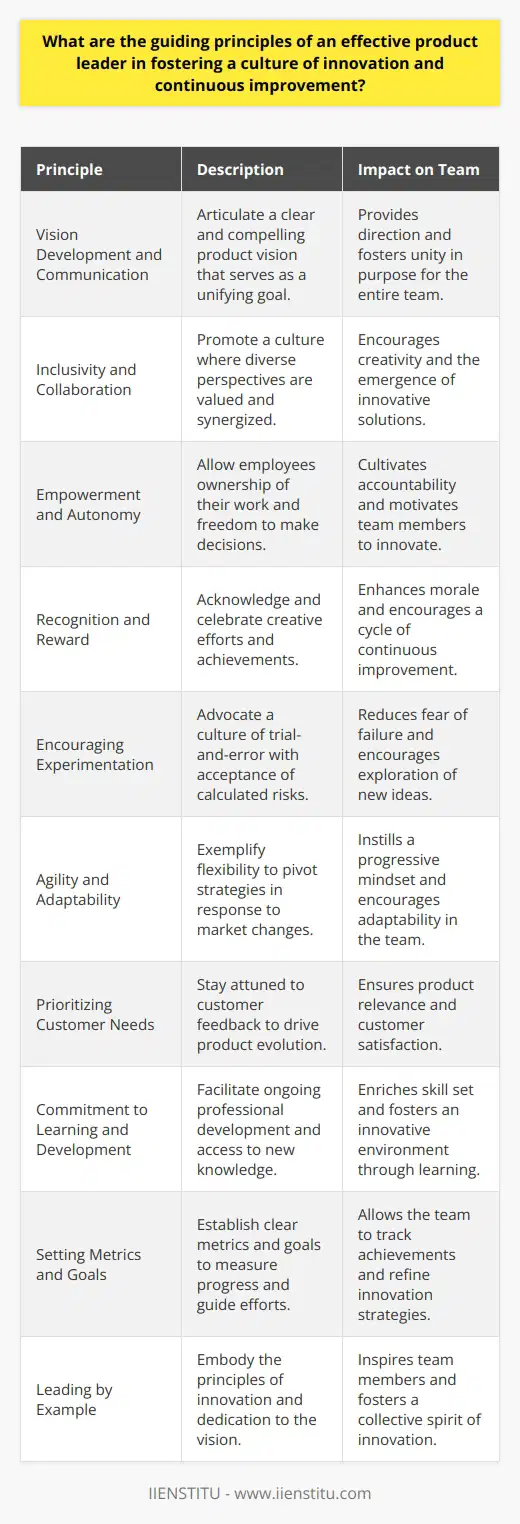
What are the leadership actions that a product manager must employ to be highly effective in driving strategic decision-making and delivering superior value to customers?
Ensuring Clear Vision and Strategy
To be highly effective in driving strategic decision-making, a product manager must first ensure a clear vision and strategy for the product. This involves setting specific, measurable, achievable, relevant, and time-bound (SMART) goals that align with the organization's objectives while addressing customer needs and market trends.
Emphasizing Collaboration and Communication
Collaboration and effective communication are critical leadership actions for product managers in driving strategic decision-making. By fostering a culture of openness and teamwork, product managers can actively involve cross-functional teams in the decision-making process. This ensures diverse perspectives are considered, leading to well-informed and data-driven decisions that deliver superior value to customers.
Adopting Customer-Centricity
A key leadership action a product manager must employ is adopting a customer-centric approach. This entails empathizing with customers, understanding their diverse needs, and designing solutions that address these needs. A product manager must champion the voice of the customer within the organization and make strategic decisions that prioritize customer satisfaction and loyalty.
Embracing Data-Driven Decision Making
Product managers must rely on data and analytics to drive effective strategic decisions. By employing a data-driven approach, product managers can identify customer trends, preferences, and pain points, helping them make informed decisions for feature prioritization, pricing strategy, and product enhancements. Additionally, data-driven product managers continuously evaluate the performance of the product and iterate quickly to increase customer value and satisfaction.
Encouraging Agility and Adaptability
In the rapidly evolving business landscape, product managers must demonstrate agility and adaptability to ensure products stay relevant and continue delivering value to customers. This involves constantly reassessing and updating product strategies in response to changing market conditions, technological advancements, and customer feedback. Agile product managers pursue a culture of continuous learning, innovation, and improvement, allowing them to pivot quickly and capitalize on emerging opportunities in the market.
In conclusion, highly effective product managers lead by ensuring clear vision and strategy, emphasizing collaboration and communication, adopting customer-centricity, embracing data-driven decision-making, and encouraging agility and adaptability. These leadership actions are crucial in driving strategic decision-making and delivering superior value to customers in today's competitive business environment.

How do you lead a team of product managers to ensure alignment with overall business goals while maintaining individual team members' autonomy and creativity?
Balancing Alignment and Autonomy
To effectively lead a team of product managers, it is essential to strike the right balance between alignment with business goals and encouraging individual autonomy and creativity. One way to achieve this balance is through regular communication and goal-setting. By establishing clear and consistent communication channels, team members are able to stay informed about organizational objectives and their role in achieving them.
Setting SMART Goals
One proven method to maintain alignment while fostering individual creativity is implementing Specific, Measurable, Attainable, Relevant, and Time-bound (SMART) goals. SMART goals ensure that team members have a clear understanding of their individual responsibilities and how they contribute to the organization's overall success. By providing transparent expectations and objectives, team leaders can empower their product managers to take ownership of their tasks and encourage innovation.
Emphasizing Cross-Functional Collaboration
Another strategy is to promote cross-functional collaboration within the team. Encouraging open lines of communication, knowledge sharing, and problem-solving across departments not only helps align the team with organizational goals but also promotes creative solutions. This approach allows for a diversity of perspectives and encourages a culture of continuous learning, fostering autonomy and creativity among team members.
Adopting a Servant Leadership Approach
Adopting a servant leadership approach is also key in striking the balance between alignment and autonomy. A servant leader's ultimate responsibility is the development and well-being of their team members, empowering them to achieve their full potential. Providing the necessary guidance and support helps create an environment where individual autonomy and creativity can thrive while ensuring alignment with business objectives.
Measuring and Celebrating Success
Finally, it is crucial to measure the team's progress towards organizational goals through regular evaluations, feedback, and progress reports. This continuous monitoring aids in keeping everyone accountable and on track. Additionally, recognizing and celebrating individual and team successes fosters a positive atmosphere and motivates team members to continue aligning their efforts with the overall business goals while maintaining their creativity and autonomy.
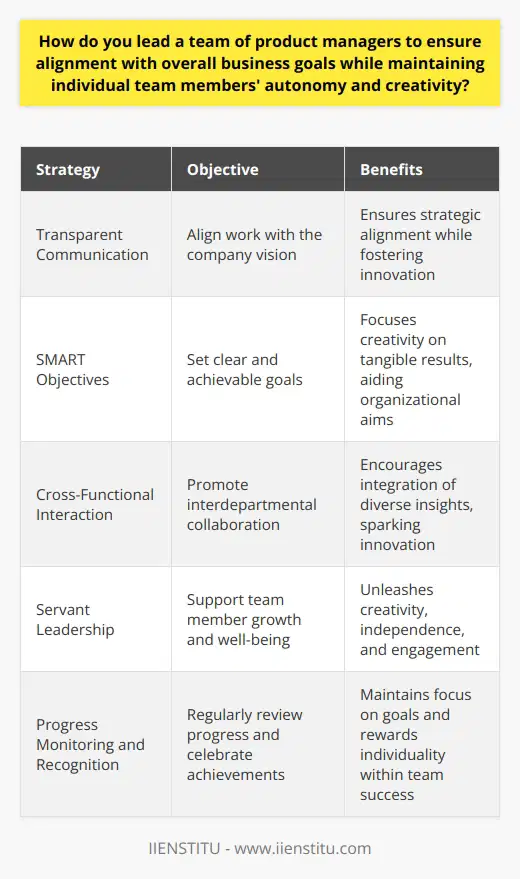
What are the guiding principles of an effective product leader in fostering a strong balance between strategic focus, operational efficiency, and innovation?
Guiding Principles for Effective Product Leadership
Strategic Focus
An effective product leader must establish a clear strategic focus to guide their team in making informed decisions. This encompasses setting specific goals and objectives, as well as prioritizing tasks that align with the organization's vision and desired outcomes. A strong strategic focus ensures that product development efforts are efficiently and consistently directed towards achieving the long-term vision.
Operational Efficiency
To foster operational efficiency, an effective product leader must streamline internal processes and remove bottlenecks. This entails creating a collaborative environment that encourages cross-functional communication, efficient decision-making, and shared accountability. Utilizing performance metrics is crucial for assessing and improving operational efficiency. By constantly refining processes and workflows, product leaders can ensure optimal resource allocation and maintain momentum in their product development efforts.
Innovation
Cultivating a culture of innovation is essential for product leaders to stay ahead in competitive markets. To achieve this, they should promote an environment that encourages experimentation, risk-taking, and continuous learning. This can be done through investments in research and development, creating spaces for ideation, and fostering collaboration among teams. Encouraging the exploration of new ideas while maintaining a sharp focus on strategic goals empowers teams to develop forward-looking solutions that address the evolving needs of customers.
Balance among Components
The challenge for product leaders lies in striking the right balance between strategic focus, operational efficiency, and innovation. Neglecting any one component can lead to inconsistencies and disjointed efforts. An effective product leader must be adept at managing the interplay between these three elements. This requires constant reassessment and agile course-correction to ensure that the necessary adjustments are made to maintain the balance.
In conclusion, the guiding principles of an effective product leader include establishing a strong strategic focus, fostering operational efficiency, and promoting innovation. By adopting a holistic approach and skillfully managing the balance among these components, product leaders can help their teams to excel in their product development efforts and deliver innovative solutions that drive business success.
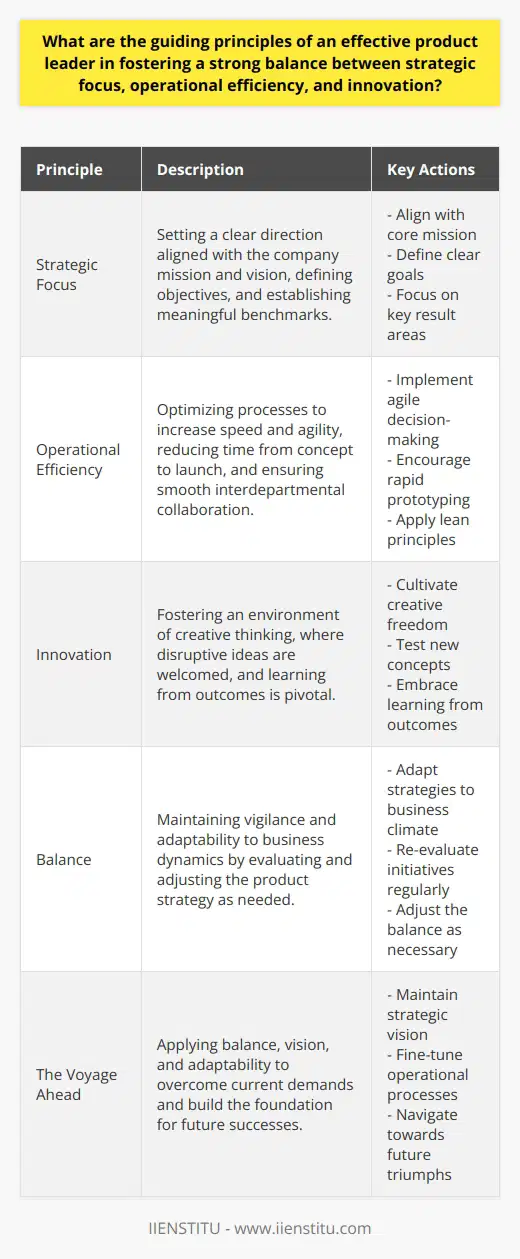
How can a product leader effectively manage cross-functional collaboration, ensuring smooth communication and coordination between various departments and stakeholders?
Establishing Clear Goals and Objectives
A product leader can effectively manage cross-functional collaboration by establishing clear goals and objectives that are communicated across all departments involved. This ensures that everyone is aligned and working towards a common purpose, preventing potential misunderstandings and conflicts.
Promoting Open Communication Channels
Encouraging open communication channels among team members from various departments is crucial. This can be achieved by holding regular meetings, creating common platforms for discussions, and sharing updates, feedback, and progress reports. By fostering a transparent work environment, everyone stays informed, and possible obstacles are resolved quickly.
Implementing Project Management Tools
Introducing and utilizing project management tools can enhance coordination among various departments and stakeholders. These tools can help allocate resources, set deadlines and prioritize work, while allowing team members to track progress easily. By using technology effectively, product leaders can maintain oversight and ensure smoother collaboration between departments.
Assigning Clear Roles and Responsibilities
A critical aspect of cross-functional collaboration is defining everyone's roles and responsibilities. By delegating tasks strategically, product leaders ensure that each department can focus on their core competencies, facilitating smooth coordination and eliminating confusion.
Providing Training and Support
Offering training and support for employees is essential to manage complex cross-functional projects. This can involve organizing workshops, seminars, or mentoring programs that equip teams with the skills needed to collaborate effectively across departments. Additionally, providing access to resources and tools relevant to their roles in the project will help employees stay engaged and contribute towards the project's success.
Nurturing a Collaborative Culture
Cultivating a collaborative culture where employees feel comfortable sharing ideas and working together is essential. A product leader needs to recognize and reward employees who showcase team spirit and display collaborative behavior. By fostering an environment that appreciates and supports teamwork, various departments and stakeholders can work cohesively towards a common goal.
Regular Assessment and Feedback
Lastly, product leaders need to assess cross-functional collaboration efforts using effective performance metrics regularly. This process involves evaluating progress, identifying roadblocks and gaps, and providing constructive feedback to respective departments. By continuously monitoring the collaboration process and implementing improvements, product leaders can ensure efficient communication and coordination among all stakeholders.

